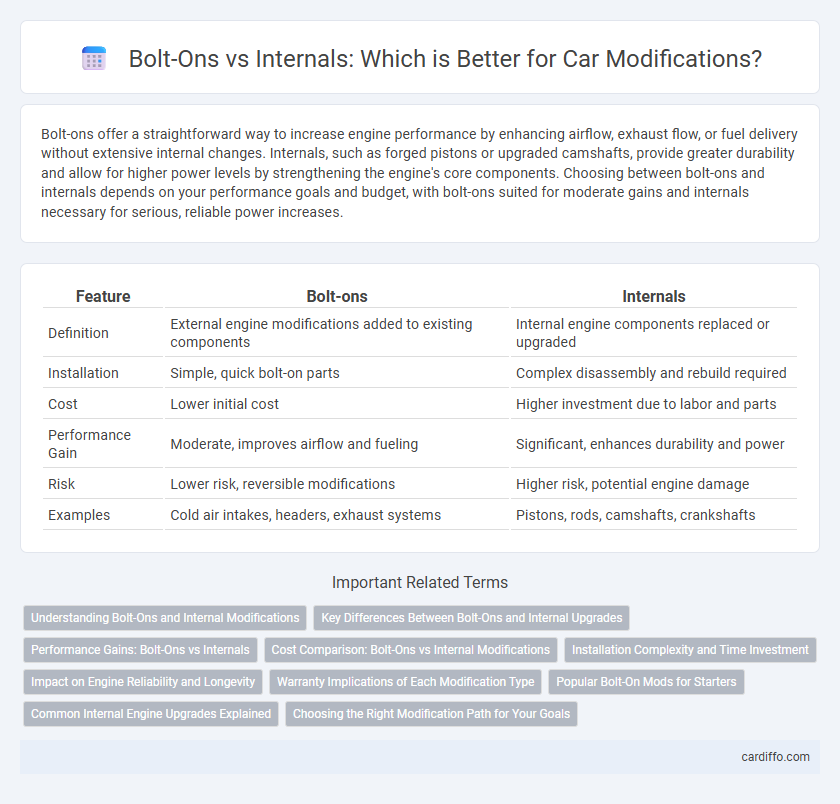Bolt-ons offer a straightforward way to increase engine performance by enhancing airflow, exhaust flow, or fuel delivery without extensive internal changes. Internals, such as forged pistons or upgraded camshafts, provide greater durability and allow for higher power levels by strengthening the engine's core components. Choosing between bolt-ons and internals depends on your performance goals and budget, with bolt-ons suited for moderate gains and internals necessary for serious, reliable power increases.
Table of Comparison
| Feature | Bolt-ons | Internals |
|---|---|---|
| Definition | External engine modifications added to existing components | Internal engine components replaced or upgraded |
| Installation | Simple, quick bolt-on parts | Complex disassembly and rebuild required |
| Cost | Lower initial cost | Higher investment due to labor and parts |
| Performance Gain | Moderate, improves airflow and fueling | Significant, enhances durability and power |
| Risk | Lower risk, reversible modifications | Higher risk, potential engine damage |
| Examples | Cold air intakes, headers, exhaust systems | Pistons, rods, camshafts, crankshafts |
Understanding Bolt-Ons and Internal Modifications
Bolt-on modifications enhance vehicle performance by adding external components such as turbochargers, exhaust systems, or intake kits, offering quick and reversible upgrades. Internal modifications involve altering engine parts like pistons, camshafts, or crankshafts, providing deeper performance gains but requiring more technical expertise and engine disassembly. Understanding the trade-offs between bolt-ons and internals helps enthusiasts balance cost, complexity, and desired power output effectively.
Key Differences Between Bolt-Ons and Internal Upgrades
Bolt-ons are external modifications that enhance performance without altering engine internals, such as intake systems, exhaust components, and ECU tuners, providing quick gains and easier installation. Internal upgrades involve replacing or reinforcing engine components like pistons, rods, and camshafts to increase strength and durability, allowing for higher boost levels and substantial power improvements. Key differences include the level of complexity, cost, and impact on engine reliability, with internal upgrades offering deeper performance potential while bolt-ons offer more accessible and less invasive enhancements.
Performance Gains: Bolt-Ons vs Internals
Bolt-ons such as cold air intakes, exhaust systems, and performance chips typically provide immediate performance gains by improving airflow and engine efficiency without extensive engine disassembly. Internals, including forged pistons, camshafts, and connecting rods, enable higher power outputs and durability by reinforcing engine components to withstand increased stress from forced induction or higher boost levels. Performance gains from internals surpass bolt-ons when aiming for significant horsepower increases and engine reliability under extreme tuning conditions.
Cost Comparison: Bolt-Ons vs Internal Modifications
Bolt-on modifications typically cost between $500 to $2,500, offering a more budget-friendly option for performance upgrades without extensive engine disassembly. Internal modifications, such as forged pistons or upgraded camshafts, often exceed $3,000 due to labor-intensive installation and precision tuning requirements. Choosing between bolt-ons and internal modifications depends on balancing upfront investment with long-term performance goals and engine reliability.
Installation Complexity and Time Investment
Bolt-on modifications generally feature lower installation complexity, requiring basic mechanical skills and minimal tools, which results in shorter time investment often under a few hours. Internals demand advanced technical expertise, precision, and specialized equipment, significantly increasing both the complexity and the time needed, sometimes extending to several days for complete installation. The higher difficulty and extended duration of internal upgrades are balanced by their potential for greater performance gains compared to the ease and efficiency of bolt-on installations.
Impact on Engine Reliability and Longevity
Bolt-on modifications typically preserve engine reliability and longevity by enhancing performance without altering internal components, thus maintaining factory tolerances and reducing stress on engine parts. Internals, such as upgraded pistons or camshafts, can significantly increase power potential but may introduce greater wear and require precise tuning to avoid compromising engine durability. Choosing bolt-ons over internals often results in a more reliable and longer-lasting engine under normal operating conditions.
Warranty Implications of Each Modification Type
Bolt-on modifications typically preserve original engine components, reducing the risk of warranty voidance by manufacturers who often view these as reversible upgrades. Internal modifications, such as forged pistons or camshafts, significantly increase the likelihood of warranty denial due to permanent changes that affect engine integrity and performance. Manufacturers commonly stipulate that internal alterations void powertrain warranties, emphasizing the critical warranty implications associated with each modification type.
Popular Bolt-On Mods for Starters
Popular bolt-on mods for starters include cold air intakes, cat-back exhaust systems, and performance chip tuning, each enhancing engine airflow, sound, and fuel efficiency without requiring extensive mechanical knowledge. These modifications typically offer noticeable power gains and improved throttle response while maintaining reliability and ease of installation. Choosing bolt-ons allows enthusiasts to customize their vehicles with minimal risk and cost compared to internal engine upgrades.
Common Internal Engine Upgrades Explained
Common internal engine upgrades involve enhancing components such as forged pistons, performance camshafts, and strengthened connecting rods to improve durability and power output. These modifications allow engines to handle increased boost levels and higher RPMs compared to bolt-on upgrades, which primarily focus on external parts like intakes, exhausts, and tuners. Internal upgrades provide a foundation for significant performance gains by ensuring the engine's core components can withstand elevated stresses.
Choosing the Right Modification Path for Your Goals
Selecting between bolt-on modifications and internal engine upgrades depends on your performance goals and budget constraints. Bolt-ons, such as intake systems, exhausts, and turbochargers, offer quicker, cost-effective power gains with easier installation compared to internals like forged pistons or camshafts, which provide durability and higher performance potential for track or competitive use. Assessing intended vehicle use, desired power increase, and long-term reliability ensures the optimal modification path aligns with your driving objectives.
Bolt-ons vs Internals Infographic

 cardiffo.com
cardiffo.com